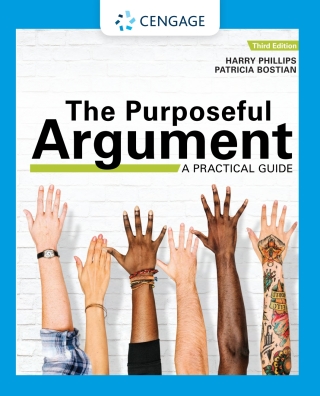Buy The Purposeful Argument: A Practical Guide with APA Updates, 3rd Edition PDF ebook by author Harry Phillips; Patricia Bostian – published by Cengage Learning in 2021 and save up to 80% compared to the print version of this textbook. With PDF version of this textbook, not only save you money, you can also highlight, add text, underline add post-it notes, bookmarks to pages, instantly search for the major terms or chapter titles, etc.
You can search our site for other versions of the The Purposeful Argument: A Practical Guide with APA Updates, 3rd Edition PDF ebook. You can also search for others PDF ebooks from publisher Cengage Learning, as well as from your favorite authors. We have thousands of online textbooks and course materials (mostly in PDF) that you can download immediately after purchase.
Note: e-textBooks do not come with access codes, CDs/DVDs, workbooks, and other supplemental items.
eBook Details:
Full title: The Purposeful Argument: A Practical Guide with APA Updates, 3rd Edition
Edition: 3rd
Copyright year: 2021
Publisher: Cengage Learning
Author: Harry Phillips; Patricia Bostian
ISBN: 9780357138748, 9780357138755
Format: PDF
Description of The Purposeful Argument: A Practical Guide with APA Updates, 3rd Edition:
Written for today’s diverse learners, THE PURPOSEFUL ARGUMENT: A PRACTICAL GUIDE, 3rd Edition, equips you with skills that are critical to success in school and well beyond. Extremely accessible, it encourages learners to argue in response to issues in a variety of environments — school, workplace, family, neighborhood, social-cultural, consumer, and concerned citizen — and illustrates how argument can become an essential negotiating skill in everyday life. Offering thorough treatments of Toulmin-based and Rogerian approaches, it teaches the value of understanding the opposition, the importance of aiming for the middle ground and how to use a microhistory to forge an unconventional position. Vivid explanations, detailed examples and practical exercises guide you step by step through the process of building an effective argument. A rich anthology of arguments covers current issues.Important Notice: Media content referenced within the product description or the product text may not be available in the ebook version.
Table of Contents of The Purposeful Argument: A Practical Guide with APA Updates, 3rd Edition PDF ebook:
Brief ContentsTable of ContentsPrefaceAcknowledgementsPart 1: How to Approach Argument in Real LifeChapter 1: Argue with a Purpose What Argument Is and What Argument Is NotRecognize Where Argument Is Appropriate in Real LifeArgue about Issues That Matter to YouEstablish Local Context via the Research ProcessRecognize Why Arguments Break DownMatch Argument with PurposeReflect and ApplyChapter 2: Explore an Issue That Matters to YouDetermine What Matters to You and WhyChoose an Issue within a TopicPre-Think about Your IssueDefine and Target Your AudienceStake, Defend, and Justify Your ClaimVary the Types of Support You Bring to an ArgumentArgue at the Right MomentGetting StartedReflect and ApplyPart 2: How to Establish Context through ResearchChapter 3: Develop a Research PlanUse Reference Works, Encyclopedias, and Topic Overviews ProfitablyUse Search Engines to Find Internet Sources on the Surface Web and on the Deep WebPerform Keyword QueriesFind News Sites and Use RSS Feeds to Receive UpdatesFind and Use Databases in LibrariesFind and Use Primary SourcesFind BooksReflect and ApplyChapter 4: Evaluate and Engage with Your SourcesTake Notes, Read Critically, and Evaluate Internet Sites Take Notes, Read Critically, and Evaluate ArticlesTake Notes and Read Books CriticallyTake Notes and Evaluate Primary SourcesIntroduce and Comment on Sources Quote and Cite QuotationsSummarize and Cite SummariesSummary ChecklistParaphrase and Cite ParaphrasesAvoid PlagiarismDocumentation: Works Cited PageReflect and ApplyChapter 5: Read Critically and Avoid FallaciesDefine FallaciesIdentify and Avoid FallaciesAvoid Fallacies of ChoiceAvoid Fallacies of SupportAvoid Fallacies of EmotionAvoid Fallacies of InconsistencyReflect and ApplyChapter 6: Work Fairly with the OppositionWhy the Opposition MattersResist Easy GeneralizationsListen to Local Voices Summarize Other Voices FairlyValue Expertise over AdvocacyAvoid Bias When You SummarizeFind Points of OverlapRespond to Other ViewsReflect and ApplyPart 3: How to Plan, Structure, and Deliver an ArgumentChapter 7: Explore an IssueUse DefinitionsDiscover Causes or ConsequencesPresent ComparisonsPropose a SolutionEvaluate Your ClaimWrite an Exploratory EssayReflect and ApplyChapter 8: Consider Toulmin-Based Argument Construct an Argument to Fit Your PurposeTerms of Toulmin-Based ArgumentMap a Toulmin-Based ArgumentStudent-Authored Toulmin-Based ArgumentReflect and ApplyChapter 9: Consider Middle-Ground Argument, Rogerian Argument, and Argument Based on a MicrohistoryMiddle-Ground ArgumentStudent-Authored Middle-Ground ArgumentRogerian ArgumentSample Rogerian ArgumentArgument Based on a MicrohistorySample Argument Based on a MicrohistoryReflect and ApplyChapter 10: Build ArgumentsHow a Claim FunctionsFive Kinds of ClaimsUse Reasons to Support Your ClaimBuild Body Paragraphs around ReasonsUse Qualifiers to Make Your Argument BelievableJustify Your Claim with a WarrantUse Your Audience to Construct a WarrantUse Backing to Support a WarrantRespond to Audience Reservations to Make a Warrant BelievableChapter 11: Support an Argument with Fact (Logos), Credibility (Ethos), and Emotion (Pathos)Field-Specific SupportUse All Three General Kinds of SupportUse Support Based on Facts and Research (Logos)Use Support to Create Credibility (Ethos)Use Support to Create Emotion (Pathos)Reflect and ApplyPart 4: How to Take Ownership of Your Argument: A Style GuideChapter 12: Enhance Your Argument with VisualsWhat Are Visual Arguments?Understanding and Using Visual ArgumentsChapter 13: Develop and Edit Argument Structure and StyleConsider Your Argument’s ClaimIntroduce Your CounterargumentsCreate Strong IntroductionsWrite Memorable ConclusionsEdit and Organize Your Argument’s SupportSupply a Strong TitleParticipate Effectively in a Peer Review SessionReflect and ApplyPart 5: An Anthology of ArgumentsIntersections: Contemporary Issues and ArgumentsAnthology 1: School and Academic CommunityAnthology 2: Workplace CommunityAnthology 3: Family and Household CommunityAnthology 4: Neighborhood CommunityAnthology 5: Social/Cultural CommunityAnthology 6: Consumer CommunityAnthology 7: Concerned Citizen CommunityAnthology 8: Classic American ArgumentsPart 6: MLA and APA Documentation SystemsAppendix A: MLA Documentation and the List of Works CitedAppendix B: APA Documentation and the Reference ListGlossaryIndex





